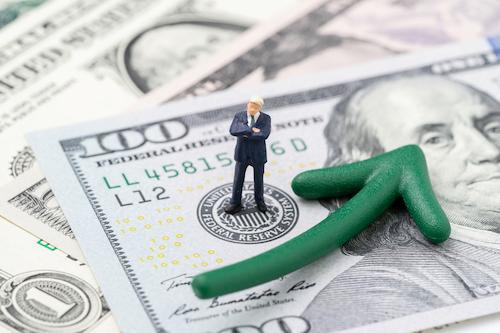
Is Inflation Rearing Its Ugly Head and Boosting Gold?
Precious metals prices have been performing strongly over the past few weeks and one of the reasons behind this is the fear that seemingly ever-rising inflation may force the U.S. Federal Reserve to raise interest rates rather sooner than it has so far been indicating. Unsurprisingly, the Fed has denied this likelihood, affirming that any rise in inflation would be “transitory,” and quotes government data releases to support this viewpoint.
To an extent, the Fed view and the supporting government data it’s cited flies in the face of consumer-experienced reality, which is indicating inflation rises well above the Fed’s 2% average target level. But the Fed adjusts its policy on the basis of the government-released data, not on consumer perceptions, and as long as inflation levels stay roughly within its target range, the Fed is likely to stand firm on its interest rate policy. At the moment, Fed chair Jay Powell is sticking to his forecast of low to technically negative interest rates, coupled with a continuation of the Quantitative Easing program, for the foreseeable future. The Fed has an inflation target of an average around 2% over time and given that it has been undershooting this target for some time now, a period of above 2% inflation, as long as it doesn’t get out of hand, might even be welcome in bringing overall average inflation up to the 2% target rate.
Even so, there is a plethora of commentators who view things differently and are talking about more serious inflation levels. Indeed, some are even predicting hyperinflation, although, what they are referring to in the American context is perhaps a rate in excess of 5%, rather than the several-hundred percent increase levels seen recently in Zimbabwe.
Those suggesting higher inflation rates, and a possible subsequent Fed interest rate rise, would seem to have had their position on this confirmed by a recent statement – since refuted as being interpreted out of context – by the new U.S. Treasury Secretary and former Fed chair, Janet Yellen. She had commented that “[i]t may be that interest rates will have to rise somewhat to make sure that our economy doesn’t overheat…” She continued that “[i]t could cause some very modest increases in interest rates to get that reallocation, but these are investments our economy needs to be competitive and to be productive (and) I think that our economy will grow faster because of them.”
However, she later went on to “clarify” this statement, saying that she wasn’t forecasting interest rate increases as a way to rein in any inflation spurred by President Biden’s proposed spending plans, noting that a rise in rates is “not something I’m predicting or recommending.” Yellen went on to say that she didn’t anticipate a bout of persistently higher inflation, but that, speaking as a former Fed chair, if inflation started to rise faster than the Fed felt comfortable with, the central bank has the tools to deal with it.
The Fed is, in any case, likely to be extremely cautious in any policy change towards increasing interest rates, given any such move could adversely affect the currently booming equities markets. Such tightening moves in the past have led to a sharp equities downturn and, should such measures be taken again, they could damage the overall feel-good factor that the Fed and the government had been doing their best to promote. In today’s political and economic environment, perception seems to be everything!
But, while the Yellen statement had been just one factor leading to better precious metals prices – and for gold in particular – there were some other supportive factors, too. Not least among these were some disappointing new job creation figures, which, although positive, came in hugely below expectations. These figures are being taken as indicating that the U.S. recovery from the pandemic-instigated recession may be progressing rather more slowly than the government would like. The U.S. dollar index has also been falling, and a lower dollar tends to result in higher precious metals prices.
Perhaps most relevant, though, was the speed at which the gold price sliced up through the perceived $1,800 psychological gold price “barrier.” This rapid increase represents a change in momentum for gold – the most visible precious metal – suggestive of even better things to come for the gold investor. At the start of the current week, gold was trading in Europe at over $1,840, a level that seemed to be holding up in early U.S. trading, too, suggesting there could well be an attack this week on the next psychological gold price barrier level of $1,850. If gold can break through here, that puts $1,900 gold and $28 silver back in our sights, making Q2 targets of $2,000 gold and $30 silver, or above, realistic figures. These levels had seemed out of reach only a few short weeks ago.
Speaking of the economic recovery from the impact of COVID-19, the rebound has been happening rather more quickly, so far, than many, including this writer, had predicted. The U.S. vaccine rollout seems to be going well after a slow start, with much of the U.S. economy getting back to near normal. Some sectors, though, have been particularly hard hit and could take years to recover, while others – notably in the tech sector – seem to have advanced, with stock indexes benefiting accordingly. The writer still feels that equities in general are hugely overvalued, by historic precedent, and are thus due for a crash – but perhaps not as severe a one as had been predicted earlier.
There had also been a consequent warning that in the aftermath of an equities crash, precious metals could also suffer. That is because those funds and individual investors who had been buying on margin could find themselves with liquidity problems, forcing them to sell strong assets along with weaker ones. But in any ensuing market crash that may occur, if the downward fall is not quite as severe as had previously been indicated, precious metals might not fall as much as expected, either. Gold, which is probably the strongest and most resilient of the precious metals, might even avoid any serious downturn altogether. Although, the more industrial-related metals – the Platinum Group Metals (PGMs), in particular, and perhaps silver, too – might not be immune from any severe downturn, and thus, may look a little more vulnerable to price falls.
There has been a suggestion that silver, in particular, is suffering something of a supply squeeze, but in this writer’s opinion, this is because the more than adequate silver supplies are perhaps in the wrong place, which is likely a temporary phenomenon. Consequently, the big premiums on silver bullion – particularly for coins and small bars – may well start coming down, thus relieving some of the silver investment price pressure.






